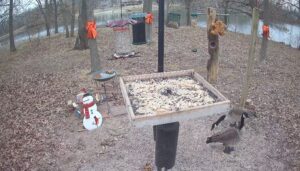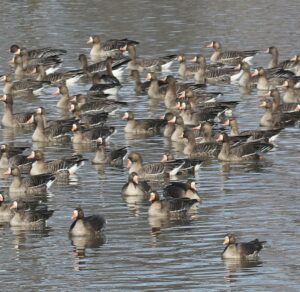Avian Flu – What Can You Do?
Avian flu is nationwide and this is the time of year when it is at its most deadly.
One way this disease is spread is through wild geese and ducks who can be carriers of the disease and from the end of January through mid April is when they are migrating. It is spread by their saliva, respiratory droplets, and feces. And when it spreads to domestic poultry, it is deadly. Entire flocks are destroyed. A poultry farmer can lose everything in a few days. For more information on all of this, please go to the website’s menu, click on Articles, then Avian Flu.
What I want to discuss in this blog is what you can do to help stop the spread of this disease. KEEP YOUR FEEDERS AND THE AREA UNDER YOUR FEEDERS CLEAN. I cannot emphasize this enough. And if you are uncertain as to how to do this, go to this website’s menu and click on Bird Feeders and Bird Baths and you will find step by step instructions.
Keeping feeders clean and also the area under your feeders raked can be very difficult this time of year. Cleon and I try hard but when the temperatures persist into single digits and below zero for several weeks as they always do this time of year, this can be difficult. And as I am typing this, I am looking out our window and we are having freezing rain. Are we really going outside to rake up unused seed, seed hulls, and bird droppings from under our feeders? Are we really going out there to take down a feeder or two to bring them inside to clean? And the answer is that we are not. But we do our best to keep to a schedule and on days that are above 20 degrees, we do the best we can to keep the area raked. Please think about this – bird feeders are a commitment and if you are not going to keep your feeders clean and disinfected, and the area underneath raked, it would be better not to put feeders up.
If you are regular watchers of the livestream cam on our feeders, you may have noticed that since the beginning of the year, as the birds bring the seed level down in a feeder, the feeder will disappear for about an hour or so. Cleon – wearing gloves – removes the feeder and brings it to our basement where I am with my rubber gloves and apron. I dump out whatever seed is remaining onto a table covered in plastic and newspaper. Right now, I am discarding all that seed. I then place the feeder in our large wash tub that is filled with hot water, an antibacterial degerent, and bleach. I then use a brush and scrub every part of the feeder, rinse it with hot water, and then pour boiling water over it. I let it air dry for a few minutes while I empty and clean out the tub and then use a small hair dryer to finish drying it so it can be placed back outside as quickly as possible. Our weather remains cold and the birds are regularly using all the feeders. The 6 feeders we have right now get cleaned on average about once every 4 days.

We are trying to rake under the feeders twice a week – sometimes we are successful and sometimes not. This is weather dependent. But if we have to wait a few days because of extremely cold weather or like today – freezing rain – then we rake as soon as we can. So far, we have no signs of avian flu at our feeders or anywhere in our yard. And remember, we are a bit more vulnerable to avian flu here as we also have Canada Geese and if you are watching the livestream, you will have noticed there is a pair hanging out under the feeders most days right now.
If you have ever closely watched a Canada Goose eat under a feeder, you will see they use their tongues to sort of lap up the seed. There is saliva on those tongues. And since they are staying under the feeders for some time, they are also defecating. Avian flu is spread through saliva and feces. So we are trying to be extra vigilant about raking up under the feeders. When we rake, we rake everything into a pile, use a dust pan, and place it all in a heavy plastic bag which we discard into the trash which goes to the landfill. This cannot be burned nor can it be placed in our compost bin. We try very hard to keep our trash that goes to the landfill to a minimum and our trash service only empties our trash can about once every 3 months – we are recyclers and we burn all our paper trash. So this is a judgement call. For these winter weeks, we feel it is better to put more into the landfill than to possibly spread avian flu and cause one of our local farmers to lose his flocks or for his livestock to become sick.
What are the symptoms birds at your feeders will show if infected with avian flu?
1. Reduced activity. This will be obvious enough that you will notice a certain bird seems lethargic.
2. Decreased appetite in one or maybe several birds. This will be hard to observe. But if you have a birdbath, you should be able to notice if a bird seems to be drinking more than it should. It will sit on the rim for long periods of time drinking and drinking.
3. Nasal discharge. Use your binoculars and focus on each bird at your feeders or in your yard. Look for droplets or small crusty areas around the beak and eyes.
4. Coughing.
5. Swelling around the eyelids – use your binoculars.
6. Diarrhea. This can be hard to determine in birds as they all squirt out their feces. But look on the ground under your feeders or on the feeders themseives – especially if the feeders have roofs. Look for lots of pale to white liquid without the dark centers.
7. Avian flu disorients birds. Look for a bird on your feeder that is sitting awkwardly or leaning, a bird that is staggering when on the ground underneath or a bird taking a short flight to a nearby branch that is awkward – like a juvenile taking its first flight.
8. Death of more than two birds at your feeders or in your yard in one day.
What should you do if you observe any of these symptoms? First thing is to take down your feeders – clean and disinfect them, discard any seed from the feeders, and rake up everything under the feeders. Do not put your feeders back up for at least a week or two. This will cause the birds to disperse and hopefully stop its spread at your feeder area. The next step is to check with the department in your state that handles wildlife. Often it is called something like The Department of Natural Resources, The Department of Fish and Wildlife, The Department of Parks. Here is what the Illinois Department of Natural Reources put out in January:
Inside Illinois DNR newsletter – January 2025
Public advised of bird flu deaths throughout Illinois
IDNR is monitoring apparent bird flu deaths at numerous
locations throughout Illinois. The public is reminded to
not handle or attempt to capture waterfowl or other wild
birds displaying signs of illness. IDNR will continue to
monitor for highly pathogenic avian influenza (HPAI)
mortality events during the seasonal bird migration. The
public is urged to report concentrations of five or more
deceased birds found at one location to IDNR.
My friend Carol from Pittsburgh, PA sent me this email:
I just checked Middle Creek Wildlife Management Area’s website. They have posted strong warnings discouraging people from coming because of the bird flu situation. Very sad. Quite a few years ago we visited the area around this time of year and saw many, many thousands of Snow Geese who had stopped there to rest and feed en route to their breeding grounds. I remember standing in the viewing area by the lake when they took off. It sounded very much like a loud freight train passing overhead. I will never forget the sight or the sound.
Middle Creek is a wonderful small refuge outside Newmanstown, PA and was created as a refuge for Snow Geese. The flocks that use it have always been spectacular! Asking the public to stay away is sad, but necessary. I have strong ties to Middle Creek as I lived close-by for almost 15 years and was there quite often.
My friend Janelle – who lives close to us here in Illinois – cleans and disinfects her feeders about every 4 days. She told me yesterday morning she had a male House Finch who stayed at her feeder with its feathers all puffed out for an extraordinarlily long time. Later the same day, she saw what she thinks was the same bird on the ground – again all its feathers puffed out – and one of her cats approached it, stared at it for some time, then gave it a push with its paw. The bird then took off and flew low and awkwardly to the trees. I am sure you will agree from its behavior, something is wrong. House Finches – all finches – seem to be more prone to disease than some of the other families of songbirds that regularly come to feeders so this could be something other than avian flu. However she is going to keep an eye out for any other birds that show signs of illness, she is going to look for dead birds, and she will follow the guidelines put out by our state. Unfortunately, she has a large property and is not able to access it all, so birds could die and she would never know it. But she will do the best she can to closely minotor what is going on at her feeders for the next few weeks.

Right now, here in central Illinois, we have flocks of Snow Geese flying overhead and I posted a video of Greater White-fronted Geese in our lake. Both are migrating back to northern Canada to nest on the tundra. And we have resident Canada Geese. Any time now, we will have migrating ducks coming through – again to nest mostly in Canada: Ring-necked Ducks, Redheads, Canvasback, Northern Pintails, Buffleheads, Scaups, Ruddy Ducks, Northern Shovelers – and the list goes on. These birds are all possible carriers of avian flu. Our poultry farmers are extremely vulnerable to this disease and losing their entire farm. Help protect birds – and farmers – by keeping your feeders and the area under your feeders clean. Protect yourself while cleaning or adding seed – ALWAYS WEAR GLOVES. And check several times a week with whatever department in your state oversees birds and animals and watch for directives. In some areas, these directives may go as far as to ask everyone to take their feeders down for a specific period of time.
If any of you have comments or observations on avian flu in your area, please use the Public Forum.

